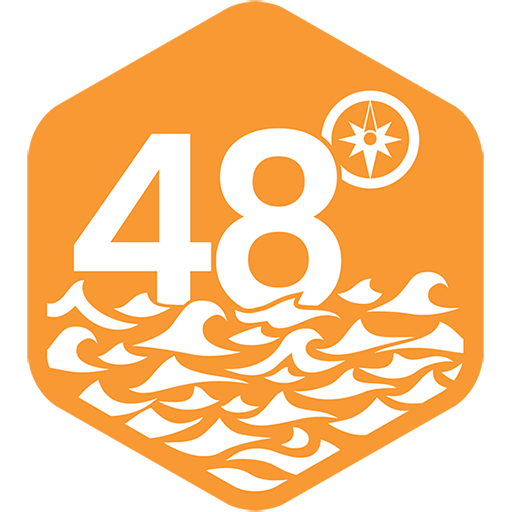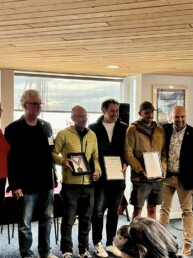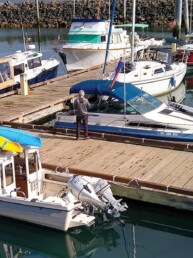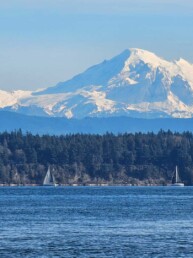“You can choose between a cooler and a toilet, but we can’t have both,” I said to my long-suffering wife, Jordy, with a sheepish look, hoping this revelation wouldn’t completely derail my vision of sailing our Drascombe Lugger Lore through British Columbia’s Sunshine Coast. At just 18 feet and with no enclosed cabin space, the little lapstrake cruiser demanded piercing decisiveness when it came to provisioning and stowage of personal effects. It was also a dreamworthy platform for a memorable journey.
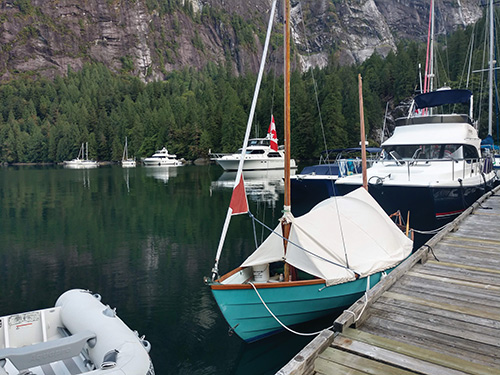
Let’s back up a bit, though. I first became intrigued by the ever-elusive Lugger while reading a series of sea stories by the intrepid adventurer Webb Chiles, who sailed his Lugger Chidiock Tichborne almost all the way around the world, nearly at the cost of his life. Luggers are rare, having only a limited run of fiberglass hulls from Devon in the U.K. A few have been built in stitch-and-glue fashion here and there, but I’d never seen a genuine article on the North Pacific Coast. Casually cruising online boat listings and classifieds is a dangerous pastime; and with the careless click of the mouse, the die was cast.
We had recently parted ways with our beloved 30-foot cruising boat, Atlas. A change in the seasons had hijacked our calendars and made the idea of continuous moorage and haul-out fees unappetizing. I also harbored some strange sense that with larger boats and modern equipment, the Salish Sea was beginning to feel small. I wasn’t sure if I liked that; after all, a life at sea with no pucker-factor is missing the point. On a related note, it seemed likely that our time as DINKs (double income, no kids) would likely be coming to an end, and I was keen to notch a season of dinghy cruising onto my belt before that window closed altogether.
I slammed the column shifter into drive and pointed my 2000 Chevy Astro van north to Lummi Island, where my treasure lay in wait. As a general principle, I never pay full price for anything on Craigslist, but in this case, I withdrew the full amount. Over the 90-minute drive, I rehearsed my best dickerings in the hope that the seller wouldn’t get wise to the fact that he had me unequivocally. In the end, I did indeed tow a boat home that day; but my poker face failed, and there was no money left for a milkshake.
I am in the habit of naming and renaming things. I like to personify my possessions—not to lose sight of their eventual worthlessness, but to be playful and in some ways to help me care for them well. I may skip some maintenance on any old Astro van, but I’d never do that to Rupert!
The Lugger had some conglomeration of letters on her transom, which meant something in another language, I can’t even remember what. I wanted to imagine that we would do storied things together, maybe even rustle up a legend or two, so I named her Lore.
Lore is stout, heavy, stiff, and rigged as a yawl with a gunter main. I could see why Webb would choose such a vessel for a grand voyage. I performed the usual new boat rituals—fresh varnish, a new sail, waxing and buffing. I even placed two large inflatable rollers along the centerboard trunk. I figured if they couldn’t sink us, they couldn’t stop us. These would also prove handy for getting Lore off the beach at low tide.
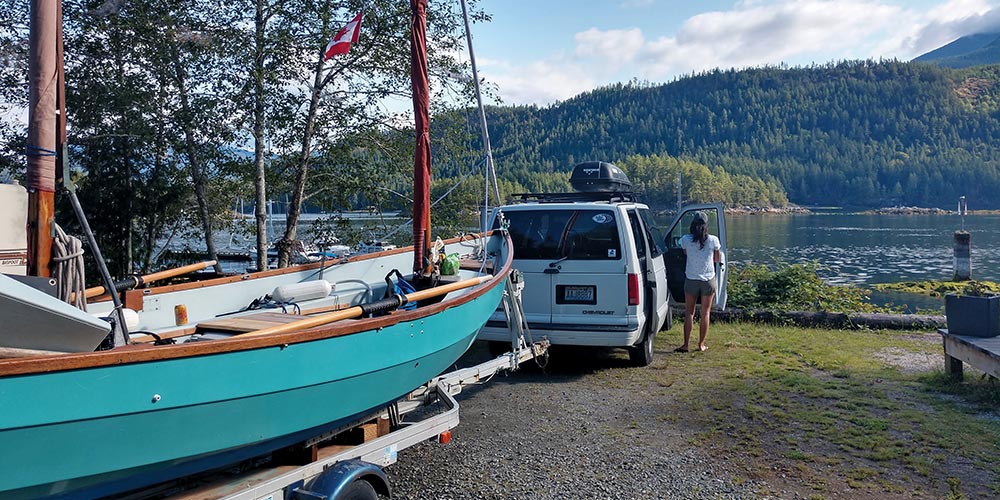
I learned just how seaworthy she was in incremental phases until circumstances forced me into our first real challenge. I had set off on my first solo mission in the San Juan Islands out of our homeport of Anacortes. I aimed to cruise for a few days before meeting some friends in Deer Harbor for the 3rd of July festivities. I had a pleasant and uneventful passage to Sucia and had stopped off for a night on Clarke Island before hanging a right for Obstruction Pass. Somewhere along the way, I had gotten sick and was already laid up on the beach. I fastened a brown canvas tarp over the yard and made a comfortable home in Lore’s open cockpit.
The illness was bad enough, and then the weather came… heavily. The last time I felt that cooped up was while stormed into my bivy for two days in Boston Basin on an attempt at Forbidden Peak. Sick, wet, cold, and suffering from cockpit fever, I determined that I could wait no more. Lore was going to sea, and I was going with her.
A 25-knot southeasterly had kicked up quite a sea state, but with a double reefed main, a partially furled jib, and a struck mizzen, we set out to weather. The iron butterflies fluttered in my stomach as I perched on the windward rail and departed the relative protection of the anchorage. My demeanor shifted about halfway to Lummi Rock. I was cold, sick, and wetter than ever from the relentless deluge of sea water gulping over the gunwale, but my confidence in Lore soared, and I donned a slight grin knowing that there were now few places we couldn’t explore together.
Dried out, recovered, and back at home, bigger plans with Lore began taking shape. We chose the towering, glaciated peaks and warm tidal waters of Princess Louisa Inlet as the primary objective of our upcoming trip to British Columbia. I’d visited the area as a teenager and had longed to return. Our vessel may have been nearly invincible but, sadly, so were our time commitments; and thus it was determined that instead of sailing the roughly 150 miles to Chatterbox Falls, we would tow the boat to Egmont and sail the 40-odd miles of Jervis Inlet before slipping through the infamous Malibu Rapids.
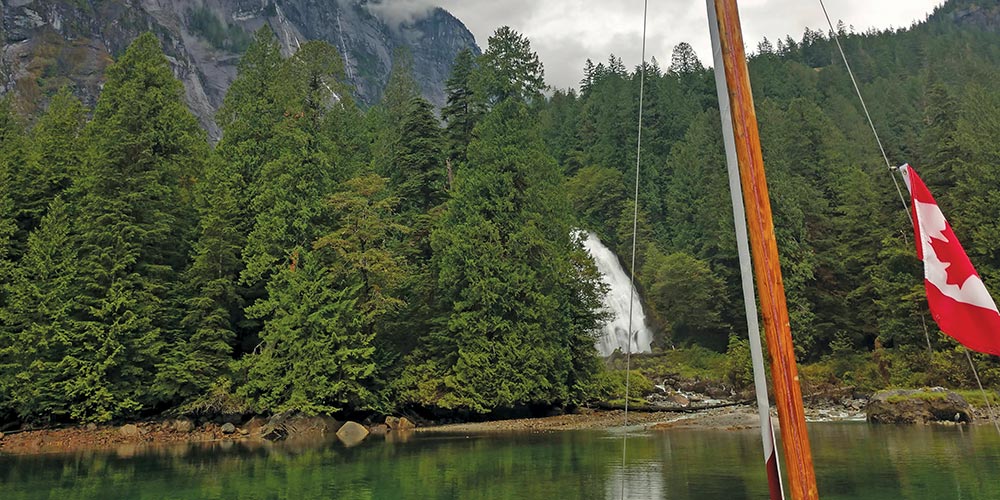
Jervis Inlet offers a unique challenge for eager mariners as the narrow reach tends to funnel thermal winds up and down at different times of the day and—in anything but the calmest conditions—provides a dearth of suitable anchorages along the way. We departed Egmont early in the morning and were quite pleased to find the morning calm, giving way to a 15 knot run with a nice following sea. We experimented with wing-on-wing sailing and eventually found success poling out the loose-footed mainsail with a telescoping boathook butted into a shoe that was lashed to the mast with a sail tie.
Lore was many things, but a fast boat was not one of them. She surfed along enthusiastically as the rumbling foam billowed along her quarters. I would have reported 10 to 12 knots of boat speed had I not seen the sorry 4.2 as clear as day on the GPS monitor. I am no mathematician, but before long it became evident that we would not make our tidal window at Malibu Rapids. I began to scour the charts for a modest bight in which to spend the night. We honed in on Deserted Bay near the northern arm of the fjord. The afternoon thermal had abated, and we found good holding in a muddy clam bed.
The solitude was gorgeous and slightly haunting. Our one-pot dinner prep was interrupted by a frightening crash not far from where Lore rested, stern-tied to a tree overhanging a quietly babbling creek that worked in vain to dilute the sea. We braced in statuesque form, catching sight of a massive bull elk as he rummaged through the bush, he offered us nothing but a slight glance and carried on his way.
The following morning, we fired up the trusty outboard and steamed the final 5 miles to the tidal rapids, which Captain Vancouver had mistaken for a coastal river as he sailed toward Queens Reach some 230 years prior. Once inside Princess Louisa Inlet, one can’t help but be overwhelmed by the beauty and grandeur. The inlet is a diminutive 4 nautical miles long and only a quarter-mile wide at points. The glaciated peaks rise to an immediate 7,000 feet of elevation, and the water plummets to depths of more than 500 feet.
The approach to Chatterbox Falls was otherworldly, and my eyes remained fixed on the stony prow of One Eye Peak, a summit I had stood atop as a younger man. The falls are the crown jewel of the inlet and, with the tide just past the morning low, we pulled up the centerboard and brought Lore’s bow to rest in the outflow of Loquilts Creek. Her Delta anchor was novelty-sized for most cruising boats, yet held well in the glistening glacial till.
The inlet’s shores are so steep that Lore’s bow rested in just inches of water while her stern floated over an invisible abyss. We rewarded ourselves with a chilling plunge in the turquoise water and basked in the hot, still August air before relocating to the nearby dock where we would cement our standing as the smallest craft in the crowd.
The other cruisers were friendly, and many would approach with the usual questions. Did you sail here? Where do you sleep? Can we bring you anything? While it was generally our policy not to accept any pity from the yachties, we made an exception when it came in the form of ice—and we were then generously treated to many cold Dark and Stormies aboard the sprawling decks of a neighboring sailboat, enough to have us stumbling back to our sleeping bags that evening.
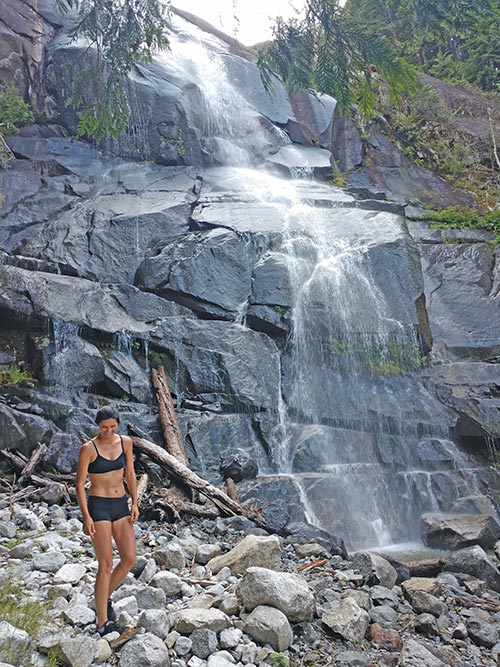
Don’t let the excitement about ice at the dock fool you into thinking that Jordy chose the cooler in our exacting preparation—she didn’t. That ice and those Dark and Stormies were just a welcome contrast to the non-perishable, one-pot meals and air-temp tap water that we had filled jugs with at the campsite in Egmont. All of these were packed snuggly around the crown jewel of our cockpit space—the porta potty.
Throughout my twenties I was an alpine guide working primarily around the north-central Cascades. We had a fun way of engaging clients with a “five-star” rating system—they could report back upon their return from whichever wilderness privy they had wandered off to. There was a star for the freshness of the air, the comfort of the seat, the lack of mosquitoes or other nuisances, the precariousness of its perch and, above all, the view. Let’s just say that our cockpit throne’s employment in Jervis and Princess Louisa deserved more than five stars!
Back at the dock at the head of the inlet, it was our version of Groundhog Day as we passed the time in a repetitive loop. Wake up, dive into the sea, swim as far up the progressively frigid outflow current as possible, hike the trail back to the boat, eat a snack, fall asleep, and repeat. We interrupted our usual programming for a strenuous hike up past the old trapper’s cabin, across the creek, and onward to a secluded window in the forest canopy offering vistas of the inlet and on to Lake McCannel, which lies hanging in the cleft of the opposing ridgeline. We returned wobbly-legged and joined some new friends for a dinghy ride to explore Macdonald Island and the painted images left by First Nations who frequented these waters long before Vancouver.
The halcyon daze of Princess Louisa was destined to end. We began to turn our focus back to what had now become lesser realities, although everything seemed to beckon us to stay, including a looming low-pressure front that had been working its way north and was closing on our hidden paradise. We awoke the following morning to a disparate scene. Rain pattered on the canvas enclosure, and a low, mysterious fog lay trapped beneath the steep surroundings. We weren’t the only ones with places to be, and a small exodus of vessels marched back toward the rapids.
Once through, we were met with a one-two punch right to the teeth. Twenty-five knots of cold, hard air and a steep breaking sea were blitzkrieging their way up Jervis Inlet. Both Lore and the 4-horse Mercury were immediately thrust into their greatest testing ground with no viable retreat. I’ve been told that the fundamentals of seamanship are: keep the water in the people, keep the water out of the boat, and keep the people out of the water. We were hoping for two out of three.
Lore bashed along violently, and we did our level best to hang on. Anything not properly stowed was airborne, and Lore’s bilge pump was working hard to keep up with the spray and occasional green water being shipped over the bow. After the first hour, our nerves had numbed, and we settled into the discomfort. The motor ran steadily, the pump kept up, and we received the occasional, comforting encouragement from new friends over the VHF radio as they passed us by, no doubt sipping tea and warming their feet by the stove. After eight hours of torment, the wind simply vanished, and the sea lay flat as if nothing had ever happened. We motored the final two hours in silence and, upon reaching Egmont, we found ourselves bellied up to the marina bar.
Jordy was a complete trooper through the entire experience, although it may not have been her personal passion. Not just this trip but the many warm-up missions that preceded it. The nights spent shivering under the brown tarp; the wet, splashy crossings of various straits; even the way the bunk boards would pinch our hind quarters when you sat up just wrong on the sleeping platform—she soldiered on without a complaint, although I could sense that I had asked, and received, more than enough.
Indeed, the Salish Sea felt big again. And though I’d seen one of its unquestioned highlights, I couldn’t wait to see more of it with Lore.
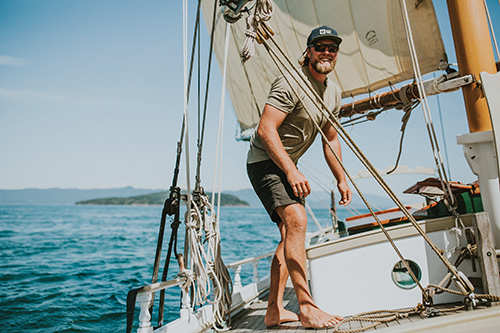
small, like their schooner Anse La Roche. Photo courtesy of Iliana Kazi Photograhy.
Kevin Pratt is a lifelong adventurer and professional mariner. Owner of Sail Anacortes and skipper to the schooner Anse La Roche, he finds fulfillment in the ebb-and-flow balance between the complexities of fatherhood, family life, mowing the lawn, and longing for whatever lies beyond the horizon.
